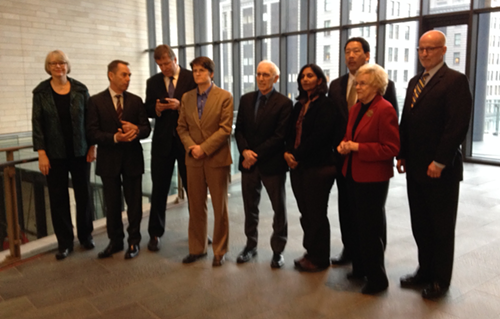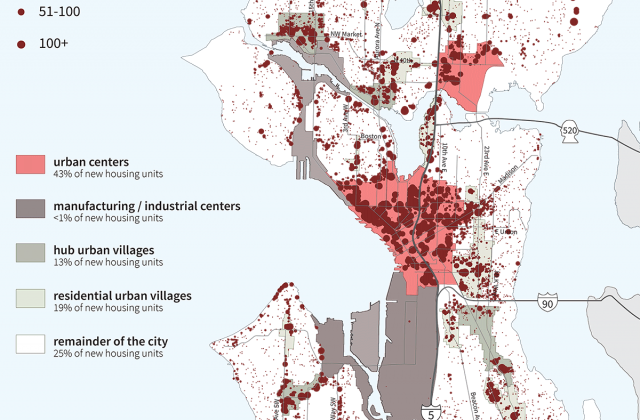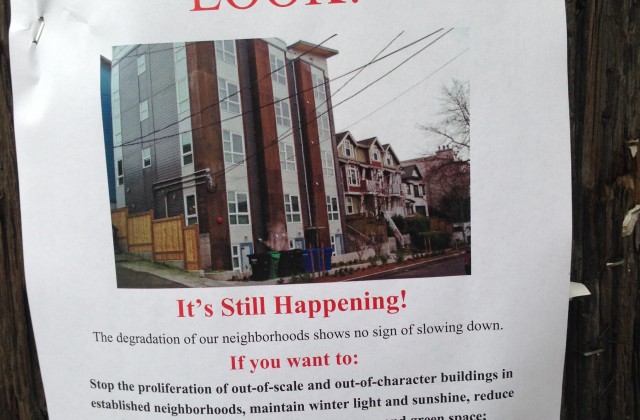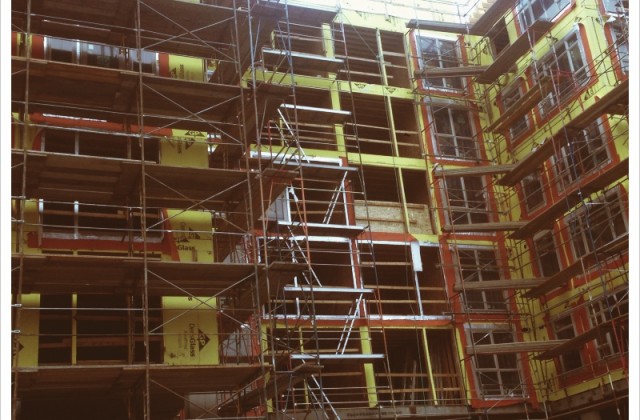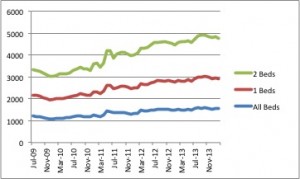PLUS Schedule: Busy Weeks Ahead
City Council staff has set out the schedule for the Planning Land Use and Sustainability (PLUS) Committee for the coming weeks. The PLUS Committee will be considering legislation that potentially can have big impacts on building of new single-family homes and microhousing. These will be some of the most important land use decisions the Council will make in this decade and they will set the tone for what happens to housing in the future.
Please get involved by letting Councilmembers hear from you and your friends that support more housing choice for people who live here, work here, and people who are moving here today and in the future. We’ll let you know more about when and where to get involved.
Small Lot Development
Issue Information:
http://www.seattle.gov/dpd/codesrules/changestocode/smalllots/background/default.htm
Committee Review Schedule:
- Tuesday April 1, 2014, 2:00pm – Committee briefing and discussion
- Friday April 18, 2014, 2:00pm – Public Hearing and committee discussion
- Tuesday May 6, 2014, 2:00pm – Committee deliberation and possible vote
Micro-Housing
Issue Information:
http://seattle.gov/DPD/codesrules/changestocode/micros/whatwhy/
Committee Review Schedule:
- Friday April 18, 2014, 2:00pm – Committee briefing and Discussion [Note: Friday meeting]
- Monday May 19, 2014, 5:30pm – Public Hearing
- Tuesday June 3, 2014, 2:00pm – Committee discussion and decision agenda
- Tuesday June 17, 2014, 2:00pm – Committee deliberation and possible vote
Design Review: Adding Color and Costs to Housing
Over at Capitol Hill Seattle yet another example of why design review adds costs and complication to housing projects.
A Department of Planning and Development representative confirmed to CHS that the developers of Viva Capitol Hill, the six-story, 105-unit mixed-use apartment building finishing construction in the triangle at 12th, E Union and Madison, has been denied a temporary certificate of occupancy over an issue with the a discrepancy between the building’s approved design and its final form.
The rep said DPD and developer Alliance Residential are working to solve the “color siding issue.”
“The building was approved with an accent color, but was built all one color,” the DPD rep said about the dispute.
The builder explains.
“You think you’re doing the right thing,” Knight said. “Then the planner came out and said what was built didn’t match renderings.”
“This is news to us.”
Knight doesn’t believe Alliance should be blamed. ”We are not convinced that we did anything wrong,” Knight said.
If you’ve ever bought a house or financed a car or done anything with a bank you know how complicated closing the deal can be. The complications are even greater with large development projects like 1111 E. Union Street which has over 100 units of housing ready to be occupied. Being denied a Certificate of Occupancy (a C of O) is every builder’s worst nightmare. It’s like having the moving truck all ready to go for your family to move a new house and finding out from the bank or real estate agent that “there’s a problem.”
The problem here has it’s origin in design review. How much of an impact will all this have on the price of rents in the building? Hard to tell. But the project is certain to get more expensive the longer the City is evaluating color palettes and schemes for the new building. Does the color of the siding really matter to someone who just got a job and needs a place to live? Probably not.
This project’s trouble with design review is a classic example of why the program needs serious revision. The developer already paid a bundle to get the project through the original process, costs that have to be made up somewhere, and that somewhere is higher rents. Now there’s another hold up right at the time the building needs to be leased up. This is the reason why we have asked that microhousing not be subjected to design review until these kinds of SNAFUs are no longer looming over every project. Part of the reasons rents go up is costs, and costs are created when color palettes get fussed over rather than letting people move in to a new home.
But is the neighborhood happy? After all the claim is that design review gives the community a chance to have influence on design. The comments and complaining have already started.
Wow. The rendering and actual are quite different regardless of the color issue. Can’t believe how cheap they went. I would of considered the rendering with the big windows and warmness to it. This looks bleak, boring and not worth the money they are charging.
Hmmmm. So it’s too cheap for what they’re charging? Now the City is micromanaging the C of O for the building which adds more costs. Unfortunately neighbors look at this and see the City not doing it’s job or doing it poorly, developers are not happy because they’re costs and risks go up, and surely the City must not be satisfied with its own inspectors who should have found this issue earlier. And through it all, Council keeps hearing that housing is too expensive. This is why! It’s time to change this costly process that makes just about everyone annoyed.
Comp Planning: All of the Above!
Let me start by saying that regional planning and planning for future growth is a serious business and it isn’t easy. The City of Seattle is currently starting a long public process around where future growth–which really means more people–should go. They have three options:
Alternative 1: Urban Center Focus
Most growth would be encouraged in our urban centers: Northgate, University District, Downtown, Uptown, South Lake Union, and Capitol/First Hill.
- More households and jobs would go in these locations than over the past 20 years
- Most new households and jobs would be located in buildings 6 or more stories tall
- Would help advance the regional growth strategy
Alternative 2: Urban Village Focus
More growth would be encouraged in urban villages, such as Columbia City, Lake City, Crown Hill, Morgan Junction, Fremont, and Eastlake.
- Closest to how household growth has been over past 20 years, but more jobs would go to villages
- Many new households and jobs would be in mixed-use buildings and apartments about 4-6 stories tall
- Would help strengthen neighborhood business districts
Alternative 3: Transit Focus
Growth would be encouraged around our existing and planned light rail stations in the Rainier Valley, Capitol Hill, the University District, Roosevelt, and Northgate.
- New urban villages would be located around the I-90 and NE 130th Street stations
- Some village boundaries around light rail stations would expand
- Taller buildings would accommodate households and jobs in urban centers while smaller buildings would be in other locations
- Would take advantage of regional transit investments
Smart Growth Seattle’s response is, yes. All of the above please!
I know that sounds flippant, but I’ve seen lots of Comprehensive Planning process come and go. Keep in mind that, for the most part, Seattle’s Comprehensive Plan is aspirational. There are aspects and elements that get tied to zoning and land use decisions. But mostly, the language in the plan is attenuated with words like “the City will strive to achieve” the goals of the plan.
And as I’ve pointed out in another post, neighborhood groups will pick and choose what to hold the City accountable for down the road. If we choose Alternative 3, the TOD option, that will be the excuse to oppose new development and housing everywhere else. All of us who participated in the choosing of that option will be called out for not following the Comprehensive Plan of the City.
Whether it is growth targets or the buildable lands report, opponents of growth will pick and choose whatever is convenient to intimidate the City Council into believing that we’ve somehow gone too far, grown too fast, and allowed too much building. And as Publicola has pointed out, most of the people from neighborhoods getting involved are simply opposed to growth in the first place. We would just as soon have the jobs and people go someplace else, they say.
So go to the meetings and get involved! Let the City know what you think about where growth should go. But we need less planning and more spontaneity in Seattle and fewer rules; and that goes for land use, and transportation. Innovation isn’t planned, it just happens. What can be planned is space and encouragement for people to take risks and try new things. That’s why I say our position is “all of the above.”
Look! It’s Still Happening! NIMBY Intolerance.
Well, I was going to use the word “bigotry” in the headline of this post. But that word doesn’t quite get at what’s going on in the postering campaign we first discovered was being planned about a week ago. It’s not that the word is too strong, but that current valance of the word bigotry is typically about beliefs or race or sexual orientation. What’s going on here is related, but it’s really an angry and bitter intolerance of anyone new. As Dominic Holden points out in his take down of the NIMBYs in Eastlake and elsewhere,
These activists are demonizing good people who need a place to live and essentially trying to push them out of town. The folks responsible for the “degradation of our neighborhoods” are the anti-housing activists.
Remember, density is people.
Here’s the language of the poster:
LOOK!
It’s Still Happening!
The degradation of our neighborhoods shows no sign of slowing down.
If you want to:
Stop the proliferation of out-of-scale and out-of-character buildings in established neighborhoods, maintain winter light and sunshine, reduce shadows, and preserve Seattle’s tree canopy and green space;
Speak-Up!
Aside from the hysteria and baiting in the language (degradation?) there are some things worth paying extra special attention to here. First is the term “established neighborhoods.”
Whenever someone uses a term like “established neighborhood” the first question one wants to ask is, “what would a disestablished neighborhood” look like? Hmmm. Maybe a poor neighborhood? The term “established” is so loaded with implied classism that it’s hard to avoid. The implication is clear from the language used by these NIMBYs: We got here first, we are ESTABLISHED! New people coming in are not established and therefore don’t count as much as we do. We matter, they don’t.
The second point I’d make is about the loss of sunshine. I’ll point out again the kinds of buildings across the street from the microhousing project in question.
I point this out because, if anyone’s morning sunshine is getting blocked, it’s the microhousing residents who are being shadowed. Because of the slope of this part of the hill, the multifamily housing on the other side of the block is killing the light and creating shadows. What do the NIMBYs propose we do about that?
And tree canopy? Microhousing doesn’t fell any trees when it gets built because it is almost always built on a lot that had another building on it first, in this case a house that been turned into an apartment building housing several people.
Finally, all good intentioned Seattlites should communicate to the Seattle City Council clearly that we are a city and a community that doesn’t tolerate code words and intolerance. If people have legitimate policy and quality of life concerns about new housing they should be listened to and yes, even compromised with if possible. But you can’t compromise with intolerance; it’s not possible and it’s not a good thing.
Urge the City Council that until opponents of new housing projects for people moving to the region have actual, real, and honest concerns that can be quantified, they shouldn’t be listened to or compromised with. Seattle Speaks Up hasn’t a single legitimate concern with mircohousing that hasn’t already been addressed. They are now resorting to fear mongering and code words. That’s not what Seattle is all about. I think that’s been established.
Speak up, and tell the City Council to disavow this kind of language and ask opponents of microhousing to stop using it.
sally.bagshaw@seattle.gov
tim.burgess@seattle.gov
sally.clark@seattle.gov
jean.godden@seattle.gov
bruce.harrell@seattle.gov
nick.licata@seattle.gov
mike.obrien@seattle.gov
tom.rasmussen@seattle.gov
Kshama.Sawant@seattle.gov
The Rents They Are a Changing
The politics of housing in Seattle are all about prices, especially monthly rents. One side of the debate argues that if we create more housing options and choices in housing location and type, we’d get better places to live and stable or lowered prices. The other side of the argument holds that when we build more housing, prices actually go up because developers want to build housing for rich people and because we knock down existing cheap housing. This second view has been taken on by both social equity advocates and no-growth advocates who argue the City should increase rules and regulations on new housing or stop new housing all together.
Central to the discussion is whether or not rents actually do go down if we allow more housing. I’ve written numerous times that it is simply a fact that rents adjust themselves based on inventory; when there is excess supply landlords compete with each other and they lower rents. On the other hand, when demand starts to outpace supply, prices go up as renters have to compete with one another for scarce housing options.
What does the Internet say about all this? Well here’s the latest from the consumer focused RentJungle.com that touts itself as The Housing Search Engine:
The average apartment rent over the prior 6 months [since February of this year] in Seattle has decreased by $45 (-3%) One bedroom units have decreased by $10.5 (-1%) and two bedroom apartments have decreased by $27 (-1%)
Yes, you’re reading that right, average rents have been going down over the last 6 months. Rents do that. They actually do go down. It’s hard to say what accounts for this shorter term decrease. But the point is that rents do change, increasing and decreasing based on market pressures from demand and lagging supply.
| Month | All Beds | 1 Beds | 2 Bed |
| Sep-13 | $1,575 | $1,415 | $1,902 |
| Oct-13 | $1,594 | $1,421 | $1,906 |
| Nov-13 | $1,574 | $1,396 | $1,880 |
| Dec-13 | $1,534 | $1,374 | $1,876 |
| Jan-14 | $1,555 | $1,379 | $1,897 |
| Feb-14 | $1,540 | $1,381 | $1,846 |
| Decrease | $(35.00) | $(34.00) | $(56.00) |
Rents also go up. Between 2009 and 2014 the average rents have increased about 20 percent, and year over year they have been going up between 4 and 5 percent per years, faster than inflation. Inflation has been ranging between negative percentages in 2009 (-2.6 percent) to very low rates so far this year (about 1.5 percent).
But have rents been affordable? Well, based on the only measure of affordability we have, the normative standard used by the Department of Housing and Urban Development (HUD), that answer is, for people who earn more money, yes. For example, in 2011, a year with a big month-to-month increase in rents (14 percent from April to May), the average rent for a one bedroom was $1,130. The HUD standard of affordability for a person earning 60 percent of Area Median Income is 35* percent of monthly income or, in 2011 dollars, $1,140 with utilities included.
It seems that people at these higher levels of income, 60 to 80 percent, make up the “rents are too high” indicator on local political dashboards. When prices start to edge up for people earning 100 percent of median income or close to it, the phrase “the rent is too damn high” gets said more often and louder. For this income level, often more mobile and affluent than poor people earning less, the aggravation of trying to find a place to live increases to levels experienced routinely by the poor. Instead of that two bedroom with a washer and dryer, a couple has to settle for a one bedroom and the search for what they did find, went longer than expected.
I don’t want to diminish this real pain. People are forced to make choices between things they want, things they need, and their financial future. An extra $100 a month is $1200 per year that could be saved, for example, for the purchase of a house or for day care or some other necessity. Having to choose a less expensive apartment might actually put someone two transfers away from work instead of one. But for people earning from 60 to 80 percent of AMI, these are challenges that can be overcome, especially if we build more housing. Poor people on the other hand face the problem of paying rent, day care, other bills, and possibly eviction.
But this is hardly a social justice or equity issue for people earning 60 to 80 percent of AMI; it is more a question of marginal utility or disutility. And what happens in Seattle politics is that just as the pain being expressed by people at these levels of income becomes the loudest, the City Council’s temptation to make more rules and “crack down” on greedy developers becomes the greatest. We start to hear “even nurses, teachers, construction workers and many other middle-wage workers”struggle to find housing. The the argument is that we should tax new growth to subsidize people at these income levels, even though poor people face the bigger housing problem.
But doing things to make it harder to build more housing when rents go up is exactly the wrong thing at the wrong time – the City Council should respond by relaxing rules, taxes, and regulations not thinking up new ones.
We will continue to press this point: when the rent feels too high, and people at higher levels of income start complaining is exactly the time to build more housing of all types in all neighborhoods for all levels of income. When we don’t do that poor people suffer even more, because, for them, smaller increases in price are even more devastating to their residual incomes and more affluent people end up occupying cheaper units longer that might become vacant if they had more options. Imposing rules, regulations, and taxes on new housing in the name of helping the poor or in the name of equity makes life worse for everyone at all levels of income, especially people who are poor who have to spend a greater percentage of their income on rent.
* A commenter questioned the math here. The HUD standard always includes an allowance for utilities. It doesn’t adjust for taxes or other residual costs. It’s why it is a terrible measure. You can read why I don’t like it and why I propose an alternative here
